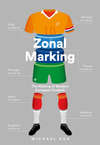Kitabı oku: «Zonal Marking», sayfa 4
Playing out from the back was not, of course, solely about goalkeepers being comfortable in possession, and Dutch football placed great emphasis on defenders who offered, in Van Gaal’s words, ‘more than just defensive skills’. English football supporters were stunned when former Ballon d’Or winner Ruud Gullit, a world-class attacking midfielder, signed for Glenn Hoddle’s Chelsea in 1995 and promptly declared his intention to play as a sweeper, the position he’d played in his teenage years. ‘As a central defender I could move into midfield and would dash from there into an attacking position,’ he said. But the experiment lasted only a couple of months at Chelsea, because Gullit’s teammates simply weren’t on the same wavelength. ‘I would take a difficult ball, control it, make space and play a good ball in front of the right-back,’ Gullit recalled. ‘Except, he didn’t want that pass. Eventually, Glenn said to me, “Ruud, it would be better if you do these things in midfield.”’ The Dutch were well ahead of the game.
This had been a crucial feature of Total Football in the 1970s: defenders bursting forward when opportunities arose, with midfielders and attackers providing cover by dropping back. To make this worthwhile, however, the Ajax and Holland sides of the 1970s required defenders to be genuinely good footballers, capable of using their freedom to provide decisive contributions in the final third. Because of the importance of pressing, meanwhile, they also needed to offer speed, to play in a high defensive line and cover the space in behind.
When the Dutch adopted this policy during the 1970s it was genuinely revolutionary. Their defensive leader was Ajax’s Ruud Krol, a gloriously complete footballer who possessed the three qualities Dutch defenders would come to be renowned for – intelligence, speed and ball-playing ability. He read the game beautifully, swept up behind his fellow defenders and knocked long, diagonal balls to the wingers, sometimes doing all three in the same move. He was the only defender aside from the legendary Bobby Moore and Franz Beckenbauer to be voted into the top three of the Ballon d’Or in the 1970s, such was his impact on club and country, and he also provided the most concise summary of the Dutch approach to defending. ‘We looked to keep our opponent on the halfway line,’ he said. ‘Our standpoint was that we were not protecting our own goal – we were attacking the halfway line.’
Krol played left-back during Holland’s run to the 1974 World Cup Final, and his three defensive colleagues were also particularly attack-minded. Right-back Wim Suurbier, also of Ajax, was renowned more for his speed and stamina than his defensive ability, and constantly charged up the wing. In the middle, Holland converted Feyenoord’s Wim Rijsbergen from a right-back into a centre-back, and most significantly redeployed Ajax’s Arie Haan, a reliable midfielder, as the side’s fourth defender, although he had never previously played in defence. It’s also telling that the only two significant foreigners who turned out for Ajax during this period, Yugoslavian Velibor Vasović and German Horst Blankenburg, both played the physical, old-school hardman role, because Ajax simply didn’t produce that kind of defender themselves. ‘The foreign players brought something different,’ Cruyff acknowledged of the 1970s Ajax side. That kind of statement in England or Italy would be about foreigners bringing flair, but in the Netherlands it was about foreigners bringing fight.
By the time Cruyff’s and Van Gaal’s sides were dominating Europe in the 1990s, both were determined to promote the concept of the ball-playing defender, helped by the back-pass reform. Cruyff continued to talk about the importance of attacking the halfway line rather than defending the goal even after his retirement, complaining about ‘defenders running back towards their own goal when they lose the ball, rather than moving forward to put pressure on the players in possession’. His Barcelona side, more than any other team of the 1990s, attempted to play in the opposition half.
Such was the emphasis on ball-playing defenders, Van Gaal referred to them using a word previously reserved for attacking midfielders. ‘In modern soccer the players in the middle of the back four – the numbers 3 and 4 – have really become the playmakers,’ he said. ‘That’s why Danny Blind and Frank Rijkaard were so important to Ajax. The number 10 certainly can’t be called a playmaker because the space in which he operates is too restricted … today’s playmakers are to be found in the centre of the back four. This means, of course, you can no longer deploy the old-fashioned, solid type of player in these positions. You have to use technically and tactically gifted players like Blind and Rijkaard.’ Blind, Ajax’s captain, had played alongside Van Gaal for seven years at Sparta Rotterdam and was a calm, technically gifted footballer. But his defensive partner Rijkaard was the real star, hailed by Cruyff in his autobiography as ‘one of the best all-round footballers I’ve ever seen – he could defend with the best of them, he organised the midfield and he still had scoring potential. All of that in one person, who also had the right mentality and a good set of brains.’
Rijkaard was a curious, reserved figure constantly suffering some form of identity crisis. He was considered a thug by many for his quite literal 1990 World Cup spat with Rudi Völler, but was actually among the most amiable footballers around. He appeared a natural leader, but when Ajax manager Cruyff wanted him to become more involved in off-field duties, Rijkaard stormed out and refused to play under him again. He became a celebrity by virtue of his footballing ability, yet he found fame suffocating. He later became a successful coach, winning the Champions League with Barcelona in 2006, but walked away from management at 50, saying, ‘I don’t see myself as an authentic coach. I’ve done something for about 16 years which isn’t a match for me.’ But, most crucially in this context, Rijkaard was an outstanding defender who didn’t just want to defend.
This was nothing new for Dutch defenders, of course, but Rijkaard’s case was particularly extreme. He emerged from Ajax’s academy and became an outstanding, forward-thinking defender, partnering Ronald Koeman at Euro 88 and finishing third in that year’s Ballon d’Or voting. While Dutchmen were accustomed to Rijkaard’s attacking quality, other managers appeared surprised. ‘This is the best central defender I’ve seen in the last few years,’ raved Argentina manager Carlos Bilardo. ‘He wins everything in the air, he marks perfectly, reads the game well, has a great long pass and a great shot. He is the perfect defender, born for today’s game.’ Ireland boss Jack Charlton repeated the praise. ‘He can do everything! In England he would be worth gold. We hardly have any like him, a player who can defend and attack brilliantly.’
Rijkaard moved to AC Milan in 1988, and because Arrigo Sacchi had created the most formidable defensive quartet of that era – Mauro Tassotti, Franco Baresi, Alessandro Costacurta and Paolo Maldini – Rijkaard was deployed in midfield alongside another future Champions League-winning manager, Carlo Ancelotti. This came to be Rijkaard’s established position; he won the 1989 European Cup from midfield and was again voted third in the Ballon d’Or, and then helped Milan retain the European Cup by scoring the only goal in the final, breaking forward from midfield, receiving a through-ball from Marco van Basten and finishing coolly. Rijkaard was now a box-to-box midfielder. But for Holland he was fielded as a central defender at the 1990 World Cup, with the midfield based around the underperforming Ruud Gullit, his Milan teammate and childhood friend. Being deployed at centre-back frustrated Rijkaard and contributed to his decision to quit the national side. He wanted to be the playmaker, not a man-marker, and only returned to international duty when promised a midfield role.
Upon his return to Ajax in 1993, Rijkaard was less mobile, more mature and happier playing defensively – so the position Van Gaal had earmarked for him was perfect. In Ajax’s 3–4–3, he played as the number 4, essentially anchoring the midfield ahead of captain Blind but dropping back to become a defender when necessary. But crucially, for a player who always wanted to be a playmaker, that’s precisely what Van Gaal demanded from him, and although asked to track opposition forwards, Rijkaard was also free to join the attack.
Rijkaard played a crucial role in Ajax’s 1995 European Cup Final win against Milan with his assist for Patrick Kluivert, but arguably more significant was the fact that he had taken control in the Ajax dressing room at half-time, laying into Clarence Seedorf and rallying his teammates, a moment Van Gaal would repeatedly cite as an example of a teammate stepping up and assuming responsibility. Rijkaard retired from football immediately after the triumphant final – which meant that his first departure from Ajax, in 1987, came after his manager Cruyff complained about his lack of leadership skills, and his second departure, in 1995, came after his manager Van Gaal was delighted with them.
Alongside Blind and Rijkaard was Frank de Boer, capable of playing left-back or left-sided centre-back, and therefore ideal for the flexible nature of Ajax’s defence. He was a wonderful distributor, particularly when spraying long, diagonal passes to a centre-forward who had drifted into the opposite channel. The classic example was the most famous Dutch pass of the 1990s, the pinpoint 60-yard diagonal to Dennis Bergkamp in the dying seconds of the 1998 World Cup quarter-final against Argentina. It was a good ball, made into a great one by Bergkamp’s extraordinary feat of bringing the ball down, beating Roberto Ayala and lifting the ball into the net with three quick touches. But Bergkamp’s favourite goal owed everything to his existing relationship with De Boer, as he explained when outlining how he received the pass. ‘You’ve had the eye contact … Frank knows exactly what he’s going to do. There’s contact, you’re watching him. He’s looking at you, you know his body language: he’s going to give the ball.’
Bergkamp knew, because De Boer had played that pass to him so often at club level, the best instance coming on Valentine’s Day 1993 at PSV. De Boer moved forward on the left of the Ajax defence and thumped a perfect curling ball into the right-hand channel for Bergkamp, who responded with a typical three-card trick: controlling the ball with his right thigh, then knocking the ball past the defender with his left foot, before chipping the ball over the goalkeeper with his right. Stripping away the context and looking purely at the technical skill involved, it was arguably more impressive than the Argentina strike. ‘It wasn’t a simple thing to do, but I’d done it so often with Dennis when we’d played together at Ajax,’ De Boer recalled when speaking of the Argentina goal. ‘When you watch the footage of Dennis at Ajax, I must have given him assists like that three or four times. We felt good together – when he went forward, I knew he wanted to go deep, and vice-versa … everything went right, and the pass was beautiful. But that was one of my strengths, and the chances of the pass getting there are higher for me than for other players.’ That’s because De Boer was simply an excellent passer, and that specific diagonal ball, from De Boer to the centre-forward, became a familiar part of Ajax’s attacking under Van Gaal.
Ajax’s final defender, right-sided Michael Reiziger, was a different type of footballer entirely: less creative but extremely quick, which meant he was the most effective defender at covering the space in behind, and lithe and tricky when bursting forward. Reiziger was another academy product, and when loaned out to Groningen was deployed as a right-winger, such were his attacking skills. ‘He’s quick, has good anticipation and sufficient ability to participate in build-up play,’ said Van Gaal, with ‘sufficient’ a telling choice of word. ‘Initially his defensive play was not so good, but this is an aspect which can be taught quickly – I give a player like him more time to play himself into the team. It’s not such a big gamble, we play near the halfway line, so Reiziger has time to use his basic speed to correct any mistakes.’
It’s crucial that Van Gaal suggested defending could be ‘taught quickly’, whereas Ajax’s passing patterns took longer to master. It was therefore much easier to convert an attacker into a defender than the other way round. In truth, Reiziger sometimes appeared to be Ajax’s weak link, but the importance of his speed shouldn’t be underestimated in combination with the guile of his defensive colleagues, and athleticism and adaptability meant that Van Gaal once declared him ‘the symbol of this Ajax side’. In all, this was the most technically gifted four-man defence football had witnessed. Significantly, three would later head to Barcelona: Reiziger in 1997, De Boer in 1999 and Rijkaard, as coach, in 2003.
But the Dutch defensive style had already been imposed at the Camp Nou by Cruyff in the early 1990s, and was naturally best epitomised by a Dutchman, the magnificent Ronald Koeman, who demonstrated a determination to attack like few other centre-backs in history. The most notable feature of his career – among eight league titles, two European Cups, the European Championship and 78 Dutch caps – is his extraordinary goalscoring tally at club level, 239 in all. He even finished joint-top goalscorer in the 1993/94 Champions League, with eight goals. Three were penalties, and Koeman also scored a number of free-kicks throughout his career – the 1992 European Cup Final winner against Sampdoria the most significant – but 239 remains a staggering figure for a player in his position. It’s 39 more than Kluivert and only 25 behind Bergkamp. Koeman is regarded as the most prolific central defender of all time.
‘I was a defender who wasn’t really a defender,’ Koeman explained. ‘I scored so many goals because I used to step forward out of defence a lot, and my coaches asked and expected me to do that. My set-pieces were a big strength too, but even in general play, I would be in those kind of positions, able to take long-range shots.’ His greatest mentor was clearly Cruyff, whom he’d played under at Ajax in 1985/86 and then, after a controversial switch to PSV, rejoined at Barcelona in 1989. His booming diagonal balls became a regular feature of Barca’s play, particularly when switching the ball out to left-winger Hristo Stoichkov, and Cruyff had a very special trust in Koeman, perhaps only rivalled by his affection for Pep Guardiola. ‘Koeman likes the football that I preach about,’ said Cruyff. ‘He’s the ideal man at the back, a defender who is good for 15 goals a season. He can live in that position because I want players like him, who can make decisive moves in tiny spaces.’
‘Koeman was one of the first central defenders with the quality not just to defend,’ said Guardiola, who Koeman took under his wing at Barca. ‘I think Johan Cruyff bought Ronald Koeman to show us, to teach us, why we need a central defender like Ronald … most of the quality was his build-up, amazing long balls, forty metres, quick balls. He is one of the best central defenders I’ve ever seen in my life.’ Koeman’s regular forward charges rarely exposed Barcelona in a defensive sense because they could rely on Guardiola’s selfless, intelligent play in the holding midfield position. This was particularly crucial when Cruyff played the 3–4–3, with Koeman the centre-back and Guardiola the holding midfielder. Guardiola, often wearing number 3 at this stage, would effectively become Barcelona’s main defender, covering for his attack-minded teammate in the original manner of Total Football.
While Guardiola is widely considered a deep midfielder, Cruyff often referred to him as a defender. ‘As a player he was tactically perfect but he said he couldn’t defend,’ said Cruyff. ‘I said: “I agree – in a limited way. You’re a bad defender if you have to cover this whole area. But if you have to defend this one small area, then you’re the best. Make sure that there are people to cover the other areas. As long as you do that, you can be a very good defender.” And he did become very good.’ Cruyff sometimes deployed Guardiola as a conventional centre-back; in late 1991 Cruyff even handed him the job of man-marking Real Madrid’s outstanding striker Emilio Butragueño, the reigning Pichichi. Perhaps the most significant example came in a 2–2 UEFA Cup draw away at Bayern Munich in April 1996; the idea of Guardiola, a midfielder, being deployed in defence would prove particularly prescient considering his own use of Javier Mascherano and Javi Martínez when later coaching these two clubs.
Cruyff insisted that Koeman and Guardiola, two players he praised primarily for their passing, were a perfectly functional pairing because of their positional strength and intelligence. ‘As the central defensive duo, they weren’t fast and they weren’t defenders,’ Cruyff admitted. But he believed there were only three passes that Barca needed to worry about: balls over the top would be intercepted by his goalkeeper, the aggressive Busquets; crossfield balls would be dealt with by his speedy full-backs Albert Ferrer and Sergi Barjuán, academy products and converted wingers; balls down the centre, meanwhile, wouldn’t be a problem because Cruyff was confident Koeman and Guardiola communicated well, and were flawless in a positional sense. Sometimes he referred to the duo as both ‘midfielder-defenders’, which summarised the Dutch interpretation of defenders – they aren’t really defenders at all.
Transition: Netherlands–Italy
Juventus required a penalty shoot-out to confirm their triumph over Ajax in the 1996 Champions League Final, but this nevertheless felt like a turning point in European football, the moment when Dutch dominance gave way to Italian ascendency. Ajax, the previous season’s Champions League winners, found themselves unable to cope with the speed and power of Juve’s forwards, and the Italian side should have killed the game before half-time.
For Ajax, the problem wasn’t simply defeat and the failure to retain their trophy, but the knowledge it was the end of an era. Midway through 1995/96 European football had been shaken by the Bosman ruling, which had two major impacts. First, players could run down their contracts and transfer elsewhere for free. Second, the three-foreigner rule was now illegal, and European clubs could field as many EU nationals as they liked.
No club suffered as much as Ajax. At the end of 1995/96 Edgar Davids, arguably Europe’s most coveted midfielder, left for AC Milan on a free transfer – previously, Ajax would have received a fee and reinvested the proceeds. Meanwhile, the liberalisation of the rules regarding the number of foreign players permitted meant there was now extra overseas demand for Ajax’s other stars, and within three years they found almost their entire Champions League-winning side had departed. Davids, Winston Bogarde, Edwin van der Sar, Michael Reiziger, Nwankwo Kanu and Patrick Kluivert all headed to Serie A, mirroring the shift in power. Bosman had made players, and Europe’s major leagues, considerably more powerful, and Ajax were no longer among Europe’s elite.
1996 also saw Ajax depart their much-loved De Meer Stadion, moving to the Amsterdam Arena – later renamed the Johan Cruyff Arena – in the south of the city. They encountered serious problems with the new stadium, which wasn’t simply a football ground, but a multipurpose arena also used for concerts. Grass didn’t grow properly, which hampered Ajax’s passing football, and to many supporters it just didn’t feel like home. Louis van Gaal initially intended to leave in 1996, but stuck around one more year for personal reasons. Cruyff, meanwhile, left Barcelona in 1996 and would never coach again, while Holland were hugely disappointing at Euro 96, thrashed 4–1 in the group stage by England, and exiting after a quarter-final penalty shoot-out defeat to France. Holland’s customary tournament arguments seemed particularly serious, too, with various suggestions of a divide between black and white players.
With Dutch football’s reputation taking a battering, then, Italy became the centre of European football. Serie A had been Europe’s strongest league throughout the 1990s, evidenced by their clubs’ dominance of the European competitions, but only now, with the sexier, more forward-thinking Ajax out of the picture, was its superiority unquestionable.
Whereas Ajax focused on youth development, Italian clubs depended on financial clout. The country’s major clubs were owned by absurdly wealthy businessmen – at least in theory, as many later found themselves financially ruined – who competed to sign the world’s greatest talents. The so-called ‘seven sisters’ of Italian football had emerged: Juventus, Milan, Inter, Roma, Lazio, Parma and Fiorentina all boasted world-class players, and all seven started each season with a genuine chance of glory. In terms of overall strength and competitiveness, there has probably never been a better league than Serie A during the mid- to late-1990s.
Stylistically, Serie A was in a peculiar place. Italian football had always been considered defensive, with its infamous catenaccio of the 1960s still influencing tactical thought. While the attack-minded Milan boss Arrigo Sacchi had revolutionised football in the late 1980s by overhauling catenaccio and introducing the pressing game, he’d been inspired by Ajax’s Total Football, and his approach was atypical for an Italian coach.
During this period Italian football’s major tactical themes were essentially debates between coaches who were pro-Sacchi and those who were Italian traditionalists. Sacchi promoted a proactive style of football in an inflexible 4–4–2 system, which featured no trequartista (the number 10) or libero (the sweeper). But, by nature, Italian coaches adapted their system to the opposition’s approach, most loved their trequartisti and many still insisted on a libero. Italian football during this era was not about following Sacchi’s Dutch-centric ideals, but about returning Serie A to the old Italian way.










